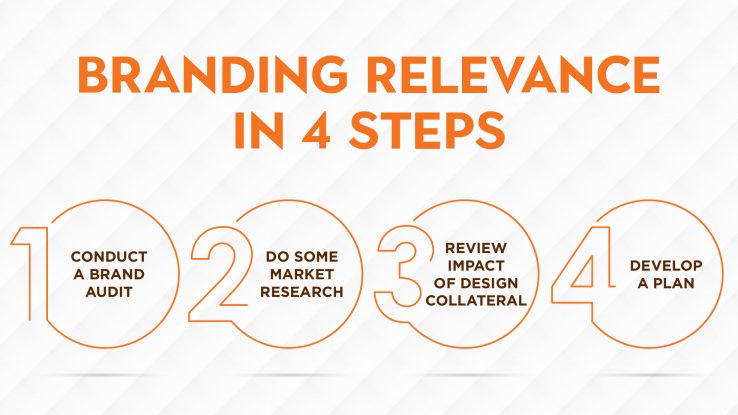Brand relevance is the ability to connect with people’s emotions and make a product or service relevant enough for them to invest in it. Why is it important? Creating brand relevance is a strong indicator of long-term success by gaining engagement, loyalty, and trust from customers for years to come.
Creating true brand relevance takes time and patience, but when done correctly can grow a brand and business for the long-term. Below are 4 steps that can help you realign your brand for success.
Step #1: Conduct a Brand Audit
Do you know what your footprint is with your target audience? Are you even getting in front of the people that will buy your product or service? Now is the time to conduct a brand audit so you know the impact of your brand and its existing gaps. Use the steps below to conduct a brand audit.
- Identify what is being measured. What is your business’s mission, vision, unique selling proposition, market position and brand promise? Who is your target audience and where are they?
- Assess marketing materials. Gather all your marketing materials, including business logo, brochures, sales sheets, product packaging, letterhead, business cards, print advertisements, website(s), social media platforms, email campaigns, and newsletters. Do they have a consistent design, color, and tone? Do they speak to your target market?
- Review your business website. Using website analytics, assess where web traffic is coming from, what the bounce rate and conversion rate is and if it is attracting your target audience.
- Review your social media data. Use your social media analytics to examine who is following and engaging with your brand. Are they current or potential customers? Are they saying anything about your brand?
Evaluate competitive brands. Assess the competitions by reviewing their marketing and advertising materials, websites, and social media platforms. What are they doing well or not so well?
Step #2: Do Some Market Research
Who does your target audience think you are? To make sure that you are talking to the right target audience and using the right mix of marketing, leverage market research to fully understand how current and potential customers feel about your brand. Use a combination of customer focus groups, email surveys, social media polls, and online surveys to get customer feedback on the following:
- What brand experience have people had?
- What has their experience been with customer service?
- Does your service or product solve customers’ problems?
- How do customers describe your service or product?
- Have they ever recommended it to friends and family?
- What does the brand’s logo make people think of?
Be sure to survey people that aren’t customers yet. Also, create a unique survey for employees to make sure they understand the brand too. If they don’t have full knowledge of the brand it is harder for them to sell it.
Step #3: Review Impact of Design Collateral
- A design audit includes analyzing all the visual and graphic elements that represent your brand externally and internally. Consistency in design has an incredible influence on customer experience and engagement. The audit should include any visual, written, and verbal communication used as a touchpoint to get the attention of current and potential customers. When conducting a visual audit look at the following:
- Patterns: Put visual elements into buckets according to the patterns that represent the brand. Look for commonalities across all platforms and identify anything is erratic and out of place.
- Tone, Voice, & Message: Does what you are saying and writing match up with the visual representation of the brand? Does it support the message represented by the logo?
This step will help to answer the question of whether your visuals tell a cohesive story and accurately represent your brand.
Step #4: Develop A Plan
The only way to truly leverage the information gained from the brand audit, market research and graphic design audit to achieve your marketing objectives is to create a to-do list! This should be a detailed plan of action that highlights goals, deliverables, tactics, and a timeline that prioritizes work to get you in front of the right people to drive engagement and sales. Below are some key activities to building a marketing plan:
- Define Business Goals & Budget
- Conduct a SWOT Analysis
- Identify Target Audience / Customer
- Develop Marketing Goals
- Define Visuals and Communication Tone
Brand relevance can lead to a strong connection between a brand and consumer. When a consumer finds your product or service necessary for them, they will build a connection with your brand through engagement and referrals that will last for years to come.

